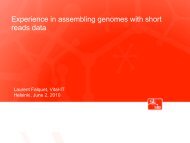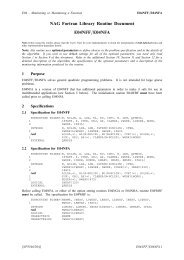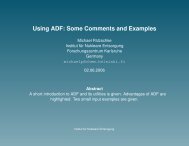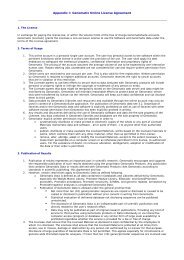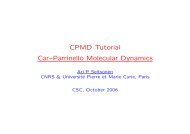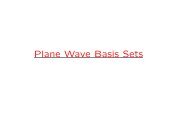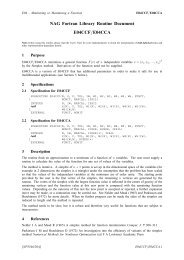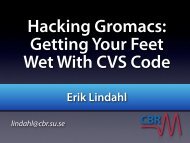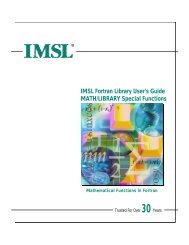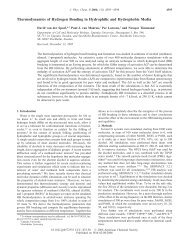Erik Lindahl
Erik Lindahl
Erik Lindahl
You also want an ePaper? Increase the reach of your titles
YUMPU automatically turns print PDFs into web optimized ePapers that Google loves.
Simulations of<br />
Membranes &<br />
Membrane Proteins<br />
<strong>Erik</strong> <strong>Lindahl</strong><br />
lindahl@cbr.su.se<br />
CBR
Outline: Membranes<br />
• Why are membranes interesting/important<br />
• Lipids - amphiphilic molecules<br />
• Micelles, bilayers, vesicles, mixtures<br />
• Bilayer phases (crystal, gel, liquid crystalline)<br />
• Special difficulties for simulations<br />
• Bilayer simulations & typical systems<br />
• Membrane proteins, transmembrane helices<br />
• Membrane protein simulations
Importance of Membranes<br />
• Controls transport into/from cells<br />
• 30% of eukaryotic proteins are<br />
associated with membranes<br />
(membrane proteins, receptors)<br />
• 50% of current drugs<br />
target membrane proteins<br />
• “Without membranes you die”<br />
(David van der Spoel, 2007)
Lipids<br />
• Charged or strongly polar<br />
(zwitterionic) headgroups<br />
• 1-2 Hydrophobic chain(s)<br />
• Amphiphilic molecules<br />
• Typical headgroups:<br />
Phosphocholine (PC)<br />
Phosphoetanolamine (PE)<br />
• Glycerol link to acyl chain<br />
• Typical chains:<br />
Palmitoyl (16 CH2 groups)
Lipid names...<br />
• DPPC - Dipalmitoylphosphatidylcholine<br />
1,2-Dipalmitoyl-sn-Glycero-3-phosphocholine<br />
• DOPG - Dioleoylphosphatidylglycerol<br />
1,2-Dioleoyl-sn-Glycero-3-phosphoglycerol (negative charge!)<br />
• POPE - Palmitoyloleoylphosphatidyletanolamine<br />
1-Palmitoyl-2-Oleoyl-sn-Glycero-3-phosphoethanolamine<br />
• DPC - Dodecylphosphocholine<br />
(single chain only, forms micelles)<br />
• Cholesterol
Lipid conformations<br />
• Large headgroups, single chain:<br />
Lipids form micelles<br />
• Higher concentration:<br />
hexagonal phases<br />
• There are also inverted micelles<br />
and hexagonal phases<br />
• Similar size headgroup/chains:<br />
Bilayers or vesicles
Bilayer phases<br />
• Very low temperature: proper crystalline phase<br />
• low temperature: gel phase<br />
• room temperature: liquid crystalline phase (Lα)
Cellular membranes
A liquid crystalline bilayer
Lipid Bilayer analysis<br />
• Experimental techniques:<br />
Neutron scattering<br />
Liquid X-ray crystallography<br />
NMR, EPR, flourescence spectroscopy<br />
• Average area/lipid<br />
• Order parameters from spectroscopy<br />
• Electron density over the bilayer<br />
• Lipid diffusion<br />
• Average properties -> great statistics!
Bilayer simulations<br />
• Lipid parameters / force fields<br />
• Topologies<br />
• Getting initial conformations<br />
• Simulation cell shapes<br />
• Interaction parameters & setup<br />
• Pressure coupling<br />
• Center-of-mass motion
Lipid force fields<br />
• Groups: phosphate, choline, glycerol, acyl<br />
• Surprisingly hard to get accurate results<br />
• Many force fields lead to lipid area & volumes<br />
that are 20% lower than experimental values!<br />
• Do NOT use: Vanilla Gromacs FF, Gromos96,<br />
OPLS-AA/L, Amber, old Charmm FF<br />
• Do USE: Berger lipid force field, Charmm27<br />
• Berger is available on Gromacs site,<br />
Charmm27 in beta for Gromacs distributions
Lipid topologies<br />
• No bilayer coordinates in PDB<br />
• No standardized atom or chain names<br />
• pdb2gmx does not work automatically<br />
• Best option: Find existing topologies<br />
(Gromacs site, Tieleman, <strong>Lindahl</strong>, others)<br />
• Alternative 1: Create RTP building blocks<br />
• Alternative 2: Hack topologies manually
Example DPPC topology<br />
;Topology for united-atom DPPC<br />
;Written by <strong>Erik</strong> <strong>Lindahl</strong>, version 980624<br />
;After a gromos version by Olle Edholm<br />
; include our own forcefield - dont use gromacs parameters!<br />
;#include "ffDPPC.itp"<br />
[moleculetype]<br />
;Name nrexcl<br />
DPPC 3<br />
[atoms]<br />
; nr type resnr residu atom cgnr charge ; Chiu charges!<br />
1 C3N 1 DPPC CN1 1 0.16<br />
2 C3N 1 DPPC CN2 1 0.16<br />
3 C3N 1 DPPC CN3 1 0.16<br />
4 NL 1 DPPC NTM 1 0.26<br />
...<br />
17 CH2 1 DPPC C1B 6 -0.04<br />
18 CH2 1 DPPC C1C 7 0.0<br />
19 CH2 1 DPPC C1D 8 0.0<br />
20 CH2 1 DPPC C1E 9 0.0
Example DPPC topology<br />
...<br />
[ dihedrals ]<br />
; ai aj ak al funct (func=1 is normal dihedrals, 3=R-B)<br />
1 4 5 6 1<br />
4 5 6 7 1<br />
...<br />
17 18 19 20 3 ; R-B torsions for acyl chains<br />
18 19 20 21 3<br />
...<br />
[ system ]<br />
; Name<br />
DPPC membrane with 28 waters per lipid<br />
J. Chem. Phys., Vol. 115, No. 10, 8 September 2001 E. <strong>Lindahl</strong> and O. Edholm<br />
[ molecules ]<br />
; Compound #mols<br />
DPPC 64<br />
SOL 3000<br />
1,4 interactions excluded<br />
R-B/Kuwajima torsions<br />
FIG. 4. The scaling is justified by the very sensitive dependence of the<br />
dynamics on the effective dihedral potential. The factor 0.7 corresponds to<br />
only 0.9 kJ/mol probably below the model accuracy. The present work em-
United vs. all atom DPPC<br />
• 50 vs 130 atoms per lipid<br />
• 3x atom density in hydrophobic region<br />
• ~9x interaction density in hydrophobic region<br />
• Roughly 4-5x simulation speed difference
Bilayer structures<br />
• Find pre-equilibrated conformations<br />
• Ask authors of published papers<br />
(works great for Gromacs topologies too)<br />
• Use genbox & genconf to change system size<br />
• Repeat single lipid conformation on grid,<br />
equilibrate for a long time in vacuo<br />
• Repeat single lipid(s), add random rotation<br />
and tilts, shorter equilibration<br />
• Simulate bilayer formation ‘the natural way’
Membrane formation
Cell shapes<br />
• Rectangular membranes<br />
• Easiest option when the simulation goal<br />
is to calculate wave-vector dependent<br />
properties (undulations, etc.)
Cell shapes<br />
• Hexagonal membranes<br />
• Maximizes periodic separation distance<br />
• Can be viewed compact/triclinic/rectangular<br />
Compact<br />
Triclinic<br />
(actual periodicity)<br />
Rectangular & whole<br />
(default output)
Coulomb interactions<br />
• Very large dipoles & parts with low dielectric<br />
screening (hydrophobic core)<br />
• Cut-offs are bad<br />
• Reaction-field would assume an isotropic and<br />
homogeneous system (not the case)<br />
• Always use PME<br />
• PME works fine with triclinic cells in Gromacs
Van der Waals stuff<br />
• One reason for the difficulties in simulating<br />
membranes is the sensitivity to nonbonded<br />
Van der Waals parameters<br />
• Small changes will affect packing of chains,<br />
and thus the pressure and area/lipid<br />
• Normal cut-off or switch around 1.0nm is OK,<br />
but turn on long-range dispersion correction<br />
to get correct pressure
Pressure coupling<br />
• Two-dimensional liquid crystals<br />
• Bilayer should be able to deform in XY-plane<br />
• Anisotropic pressure coupling should be<br />
enabled throughout production runs!<br />
• Neat trick: Semiisotropic coupling (XY+Z)<br />
• Berendsen coupling does not provide a true<br />
NPT ensemble - Parinello-Rahman is better<br />
• Slow relaxation (10ps) to avoid oscillations
Compressibility<br />
• Water value works fine as approximation<br />
• Compressibility is really a 3x3 tensor<br />
Gromacs: 3 diagonal + 3 off-diagonal elements<br />
• Off-diagonal elements zero:<br />
only scale cell along the box vectors<br />
• Off-diagonal elements same as diagonal:<br />
Enable cell distortion/shear transformations<br />
• You can also force the cell to distort by setting<br />
off-diagonal reference pressure to non-zero
Thermostats<br />
• Polar and non-polar parts of the system are<br />
not always strongly coupled<br />
• Bond constraints remove kinetic energy:<br />
anisotropic temperature in acyl chains!<br />
• Use separate thermostats for water & lipids,<br />
and also protein(s) if present
Center-of-mass motion<br />
• Center-of-mass motion of<br />
entire system normally<br />
removed in simulations<br />
• Weak z-coupling in bilayers:<br />
• Water moves right, lipids left<br />
• Upper layer right, lower left<br />
• Remove center-of-mass<br />
motion separately for:<br />
water, upper layer, lower layer<br />
comm_grps = upper lower SOL
Lipid diffusion<br />
• Frequently overestimated by an order<br />
of magnitude due to layer c-o-m motion!<br />
• Can be corrected after simulations too, though<br />
J. Chem. Phys., Vol. 115, No. 10, 8 September 2001 NMR relaxation in lipid bilayers<br />
4943<br />
vesicle tumbling or collective effects. We have derived analytical<br />
corrections for these contributions in appendix A, but<br />
none of the alternatives produce an asymptotic 1/ behavior.<br />
The proposed frequency dependence thus seems to be a<br />
good phenomenological model for the relatively limited frequency<br />
range covered by NMR experiments and mainly<br />
caused by the nonexponential relaxation from chain isomerization,<br />
but it would be quite puzzling if it persists to much<br />
lower frequencies in future measurements. In the opposite<br />
limit of high frequencies, simulations can access much<br />
higher regions than NMR experiments. Since the decay of<br />
the correlation function is strongly nonexponential even at<br />
short times, the calculated NMR relaxation rate does not approach<br />
a finite nonzero value in the limit of very high frequencies.<br />
On the contrary, it continues to zero.<br />
10 ns 100 ns MSD (10x slower than H2O)<br />
B. Lipid translational & reorientational diffusion<br />
FIG. 5. Center-of-mass mean square displacement of the lipids solid and<br />
the linear regression dashed. The inset shows probability distributions of<br />
one-dimensional displacements, i.e., diffusion propagators, for motions over
Electron density<br />
• g_density<br />
You need to provide electrons.dat with<br />
4.1. Composition & Structure 41<br />
number of electrons/atom, see -h flag.<br />
500<br />
Electron density (nm -3 )<br />
400<br />
300<br />
200<br />
100<br />
-3 -2 -1 0 1 2 3<br />
Distance from bilayer center (nm)
Order parameters<br />
• g_order (requires index file with i-1, i+1)<br />
S CD = 3〈 cos 2 θ 〉 − 1<br />
42 Chapter 4. Membranes<br />
2<br />
-0.3<br />
S CD<br />
-0.2<br />
i-1<br />
i<br />
C<br />
H(D)<br />
-0.1<br />
i+1<br />
5 10 15<br />
Carbon atom<br />
Figure 4.3. Order parameters for the C–H vectors (experimentally C–D) in the lipid
Undulations<br />
• Assign lipid z-coordinates to a grid<br />
• Perform 2D Fourier transforms<br />
• Plot amplitides vs. wave vector magnitude
Example: cholesterol<br />
(Cells can control membrane stiffness with cholesterol)
Undulations<br />
A<br />
B<br />
10 -2<br />
intensity (nm 2 )<br />
10 -3<br />
10 -4<br />
Collective<br />
Membrane Motion<br />
Single<br />
Lipid Motion<br />
2<br />
0.5 1.0 5<br />
wavenumber (nm -1 )
Membrane proteins<br />
• Prepare structure<br />
without membrane<br />
• Solvate protein in bilayer,<br />
e.g. with genbox<br />
• Add solvent water<br />
• Freeze protein for relaxation<br />
freezegrps = protein<br />
freezedim = y y y<br />
• Avoid water entering between<br />
lipids and protein by restraining<br />
the water z coordinates
Water restraints<br />
• Open the topology in a text file, and after the<br />
water #include line add<br />
; Position restraint for each water oxygen<br />
[ position_restraints ]<br />
; i funct fcx fcy fcz<br />
1 1 0 0 1000<br />
• Waters are free in XY-plane, but z-restrained<br />
• Works for lipids too in really bad system<br />
• Equlibrate lipids ~10ns, then water too<br />
• If water enters the membrane, remove it<br />
• Multiple equilibration cycles can be necessary
Mixed lipid & protein FFs<br />
• Berger force field does not include proteins<br />
However: Based on OPLS, so it mixes nicely<br />
with OPLS-AA/L (all-atom) for proteins!<br />
• Charmm27 OK too (but 4-5x more expensive)<br />
• Pure Gromos96, OPLS-AA/L, Amber, etc:<br />
constrain cell dimensions for reasonable lipid<br />
density & area - can still be OK if lipids are<br />
mainly passive solvent for your protein
United vs. All-atom - 1<br />
• The Berger force field performs equally well,<br />
if not better, compared to Charmm27<br />
• Hydrogens on chains only have low charge<br />
No net charge - extremely weak dipoles!<br />
• In principle the weak dipoles could aid the<br />
solvation of polar/charged groups<br />
• However, in practice the Berger force field<br />
mixed with OPLS-AA reproduce these<br />
experimental values very well too!
Bilayer solvation<br />
in vivo hydrophobicity (kcal/mol)<br />
3<br />
2<br />
1<br />
0<br />
D<br />
K<br />
E<br />
R<br />
P<br />
Q<br />
N<br />
H<br />
T<br />
W<br />
S<br />
Y<br />
A M<br />
L I C<br />
V F<br />
0 1 2 3<br />
This work (kcal/mol)<br />
If anything, the<br />
solvation cost<br />
is slightly low<br />
compared to<br />
in vivo values!
United vs. All-atom - 2<br />
• Nothing wrong with all-atom force fields<br />
• For proteins in water the difference is<br />
negligible<br />
• But not for membranes - significant<br />
performace boost with united atom model<br />
• “Proof is in the pudding”<br />
• Hard to justify 4x increased cost without any<br />
indication the results would be better<br />
• Sampling still worse issue than FF details!
Summary<br />
• Easier than proteins: 256-1024 lipids provide<br />
way better statistics<br />
• Harder than proteins: Quite sensitive to force<br />
field details, less work done<br />
• Very slow processes (>100ns)<br />
• Interesting non-equilibrium biology: ion<br />
transport, insertion, vesicle formation, etc.<br />
• Membranes scale great (>1000 CPUs in CVS)



